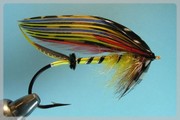|
Tying the White Ghost - a Pre-Fab Fly.
|
|
Maine's Carrie Stevens created a unique way of assembling her streamers, using pre-fabricated wings, glued together in advance of tying the fly. This pre-fabrication makes these flies a real breeze to do, and they are quite impressive when completed. They really catch fish too. The one we'll tackle here is the White Ghost, a variation of her famous Gray Ghost.
I'm asked all the time what sort of hackle one should use for these streamers, Deceiver hackle, Whiting American, Genetic wet fly hackle, Bugger packs, Chinese hen hackle, Indian necks, what? The answer is yes. Use all of the above and then some. You're looking ideally for hackle with rounded ends, with a great deal of taper, going from relatively narrow to very wide at the shoulder. Unhappily, these characteristics, the old "Spade" hackle, have been largely bred out of today's birds, so you're on your own. Do the best you can to find something that will work in the size that you need. Here is some hackle that I've selected from a Deceiver pack, that I will use for the wings on our White Ghost. I've used feathers that curve down a bit on the ends, matching the curves for each side of the wing, and I've tried to find feathers that are close in size. The butts have been trimmed up so the feathers match perfectly in length.
|
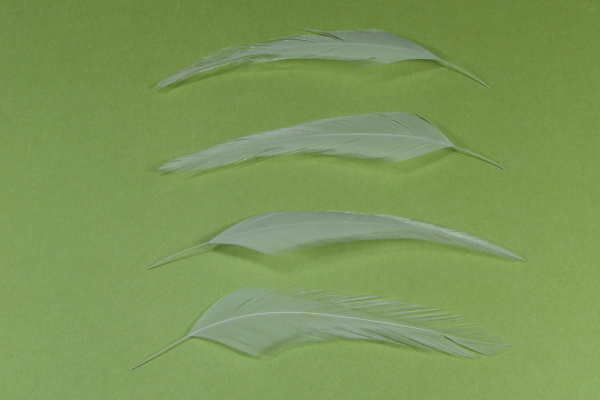
|
|
In this picture I've glued the corresponding feathers together to make two wings. Glue just the stems, up into the shoulder area a little, along the stem of the "inside" feather. Try not to have the glue show much. I used Sally Hanson's Hard as Nails here, Carrie Stevens used lacquer. Vinyl cement or Dave's Flexament might work even better.
|
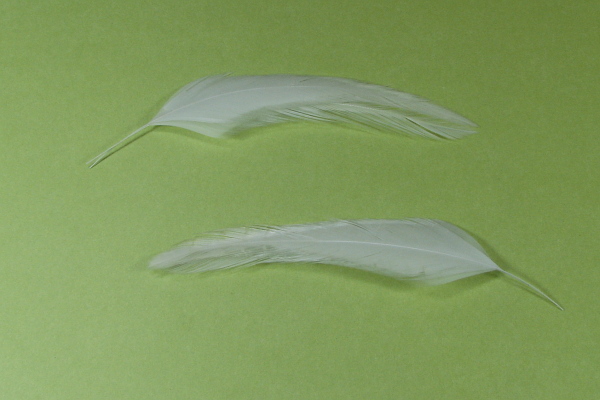
|
|
Next assemble both shoulders, coating the back of a jungle cock eye feather in the black areas only, then pressing it into the Silver pheasant. The jungle cock cheek should extend about halfway down the shoulder feather. I would have liked to have had the silver pheasant feathers turn down a bit to match the shape of the feathers on a side, and have the jungle cock eye flow the same direction. I'm down to my last few silver pheasant feathers however, so it wasn't possible to do on one side. Both pheasant feathers were more or less straight anyway, so not a big deal.
|
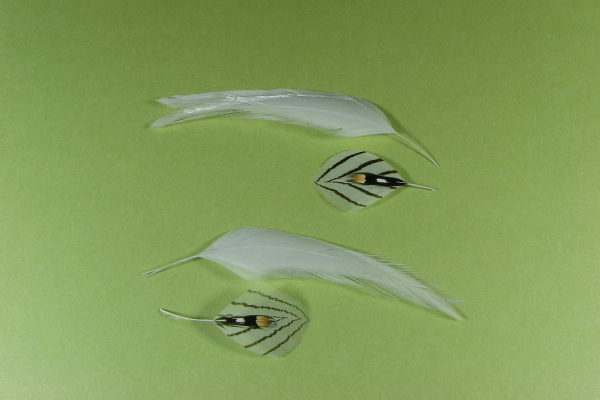
|
|
Glue the shoulder/cheek assemblies to the assembled hackle feathers. In this case, before doing so, I curled the one shoulder assembly's stems a bit,the one that curved the wrong way, so it could be easily glued. I did this with one blade of my scissors, like curling ribbon. Here are the two completed sides of the wing:
|
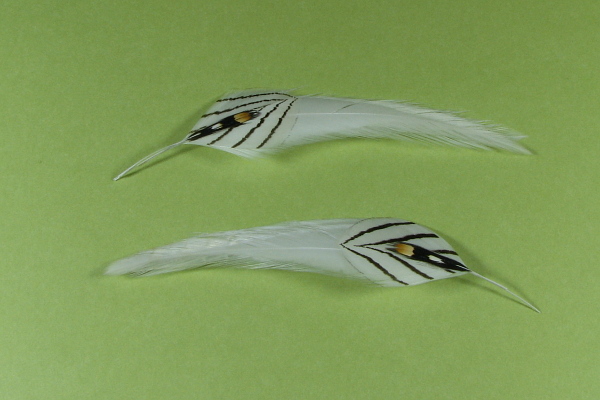
|
|
Now select a hook that is the right length for the wings you've done, about 1/4 again as long as the hook. You may do this the other way 'round, start with the hook, but I was more interested in getting the pre-fabbed wings right. Spend a lot of time selecting just the right materials for the sides, ones that match in length and slope the way you want. Start the thread behind the eye of the hook about a barb length, then wind back to a point several wraps short of the hook point. The trick to winding on a 10x long hook is to grasp the shank with the left hand just behind where you're winding, so the shank doesn't bend as much. Tie in the ribbing then the floss, both on the far side of the hook. Use two strands of Danville 4 strand rayon floss, or one of the three strands of Largartun if you want to use silk. I used metal tinsel here (not necessary, I just like the look), and if you do that, cut the edge you tie in at a very acute angle, long, so it doesn't add a lot of bulk under the floss. When using Mylar, make sure that the side you want to show (silver here) is tied in next to the shank. Now wind the thread back to the front, and establish a smooth base.
|
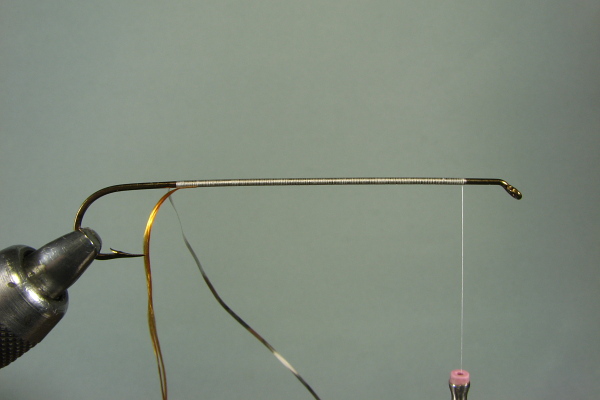
|
|
Next wind the floss all the way to the front as evenly as possible. Let the floss slip through your fingers as you wind, and you may overwrap the previous wrap just a little if you like. Edge to edge is probably best, but can leave gaps if you're not careful. Secure well with either half hitches or trap the floss by wrapping one wrap over, one wrap in front, then another over the floss. No matter how you do it, do it. It's heartbreaking when you lose the floss.
|
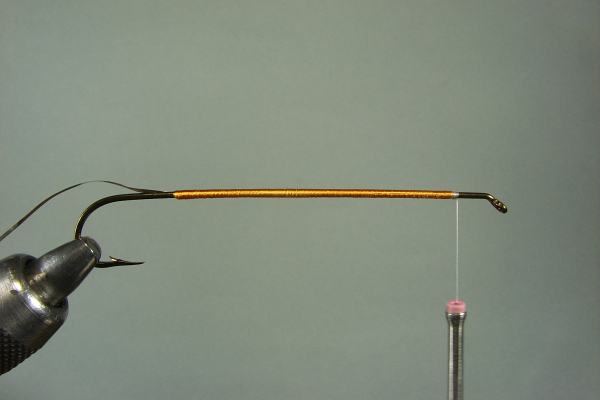
|
|
Now wind the tinsel back to the hook point, then forward to form the tag. Keep going, and wrap evenly spaced wraps all the way to the front. Tie off, and if you're using metal, be careful that the edges don't cut your thread. Don't cut the tinsel until you've completely secured it. I should mention that Carrie Stevens wrapped her tinsel counter clockwise with respect to the eye, angling her tinsel wraps back, not forward as I have done here. That said, many tiers since have angled them forward, as that's the way it's done on most other flies. I was going to angle them back, then forgot and did it the way I always do. Either way is acceptable.
|
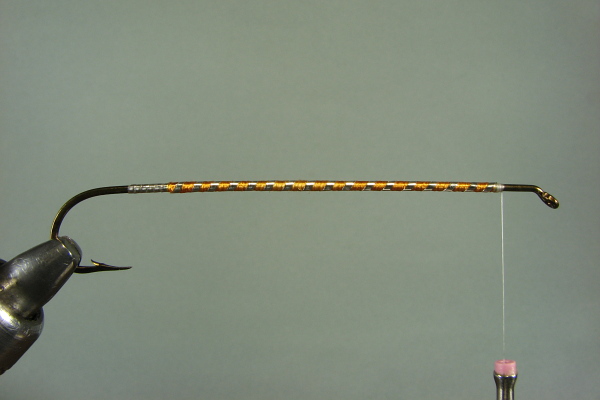
|
|
Attach four to six strands of herl under the hook, and endeavor to keep them in a bundle together as best you can. They should be about as long as the wing will be. It helps to select nice straight herl, and make your first wraps softer. Otherwise, the herl will flare out. You may glue the butts as you tie them in. Maine's Mike Martinek, Jr., a great exponent of these flies, uses glue throughout, on virtually every stage.
|
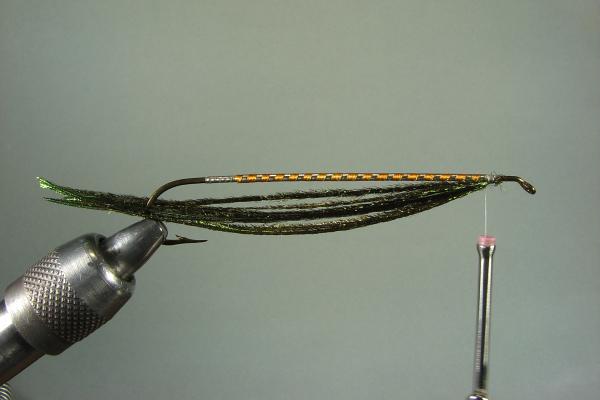
|
|
Speaking of glue, this is one stage where it's practically a must. The bucktail will pull right out if you don't do something. Very good wax wouldn't hurt, but glue's even better. The longest part of the bucktail should be as long as the herl. Don't overdo the bucktail, less is more.
|
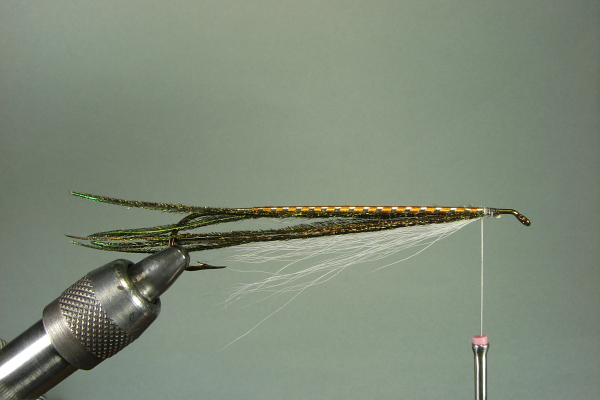
|
|
Now attach the first bunch of hackle, which consists of matched sections from the left and right sides of a schlappen feather. Keep adding these bunches one in front of the other until you are forward enough for the crest to be put on.
|
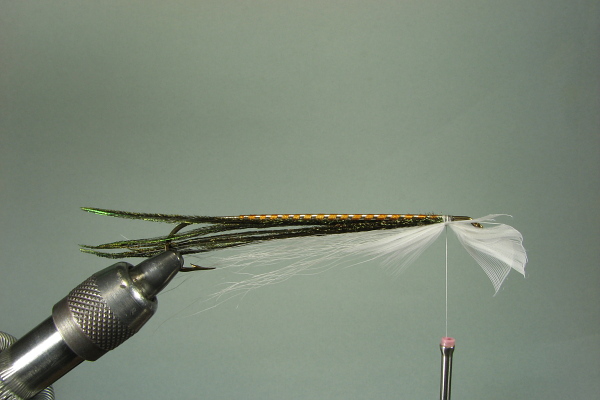
|
|
I've done another bunch of schlappen, shown here:
|
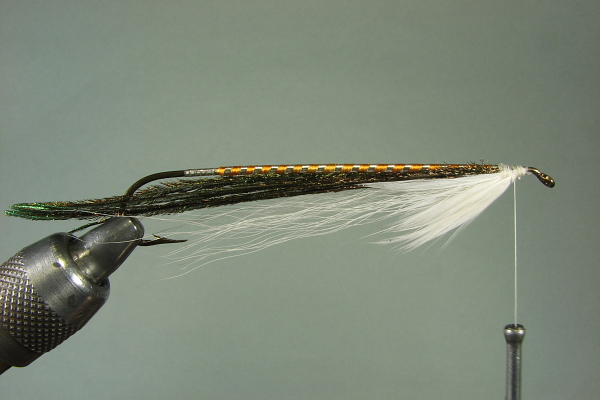
|
|
Next attach a golden pheasant crest as a throat, and another as a part of the wing.
|
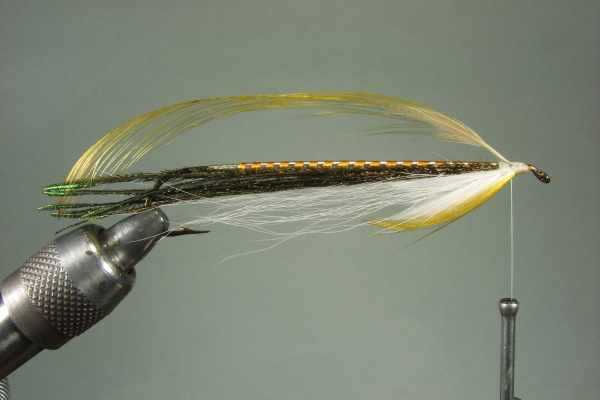
|
|
Now, before you tie your wings on, switch to black thread. Mike Martinek suggests doing another section of schlappen on TOP of the hook, which will fill in between the two sides after they're tied on. I didn't do that on this one, but it is a nice trick. With this one I tented the tops of the sides together, and after a little trial and error and fiddling around I got them where I wanted them, and decided I didn't need the schlappen. Carrie Stevens did not appear to have used this extra top schlappen in the little documentation of her techniques that are available, but it does show up on some of her flies.
|
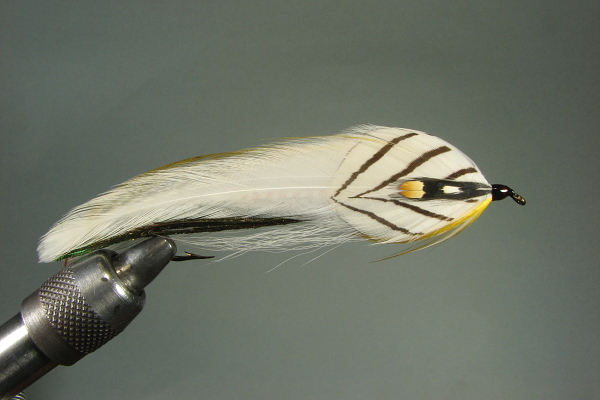
|
|
I should reiterate that these flies are not the least bit difficult. I would encourage you to try some Carrie Stevens streamers, they're fun to tie and with a little patience and material selection up front, they'll turn out fine. Give one a shot!
|
White Ghost Recipe
|
|
Tag: Flat silver tinsel
Body: Orange floss
Ribbing: Flat silver tinsel
Underbelly: Four to six strands of peacock herl, then white bucktail
Throat: White hackle fibers then a golden pheasant crest
Wing: A golden pheasant crest; Four white hackles
Shoulders: Silver pheasant body feather
Cheeks: Jungle cock
Head: Black with an orange band
|
